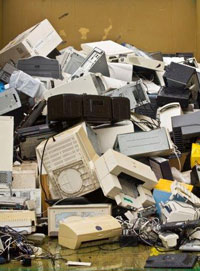| Jul 23, 2014 | |
The geography of the global electronic waste burden |
|
| (Nanowerk News) As local and national governments struggle to deal with ever-growing piles of electronic waste (or “e-waste”), scientists are now refining the picture of just how much there is and where it really ends up. | |
 Published in the ACS journal Environmental Science & Technology ("Tracking the Global Generation and Exports of e-Waste. Do Existing Estimates Add up?"), their study found that nearly a quarter of e-waste that developed countries discard floods into just seven developing countries — with major potential health risks for the people who live there. Knut Breivik and colleagues note that the export from developed to developing regions of e-waste — everything from used TVs and refrigerators to computers and cell phones — has caused concern. On one hand, this practice can help people in resource-poor countries acquire technology or earn income from selling re-usable parts and raw materials from the waste. But on the other, environmental regulations and enforcement in developing countries are often too weak to protect local people and their environment from the waste’s toxins, including lead and mercury, which are known to make people sick. To help address this mounting problem, Breivik’s team decided to pinpoint how much e-waste the world is discarding and where it goes. |
|
| Past estimates on the flow of e-waste vary, so the researchers analyzed data from many studies to arrive at more reliable numbers. They estimated that in 2005, more than 38 million tons of used electronics were discarded worldwide. Nearly a quarter of the waste from developed nations went to China, India and five West African countries: Nigeria, Ghana, Ivory Coast, Benin and Liberia. Others have predicted that e-waste will top 72 million tons by 2017. A better understanding of the fate of e-waste could inform how the world deals with it, the researchers say. |
| Source: By Jennifer Chu, MIT |
